2006 VOLKSWAGEN GOLF MK5 warning
[x] Cancel search: warningPage 240 of 444
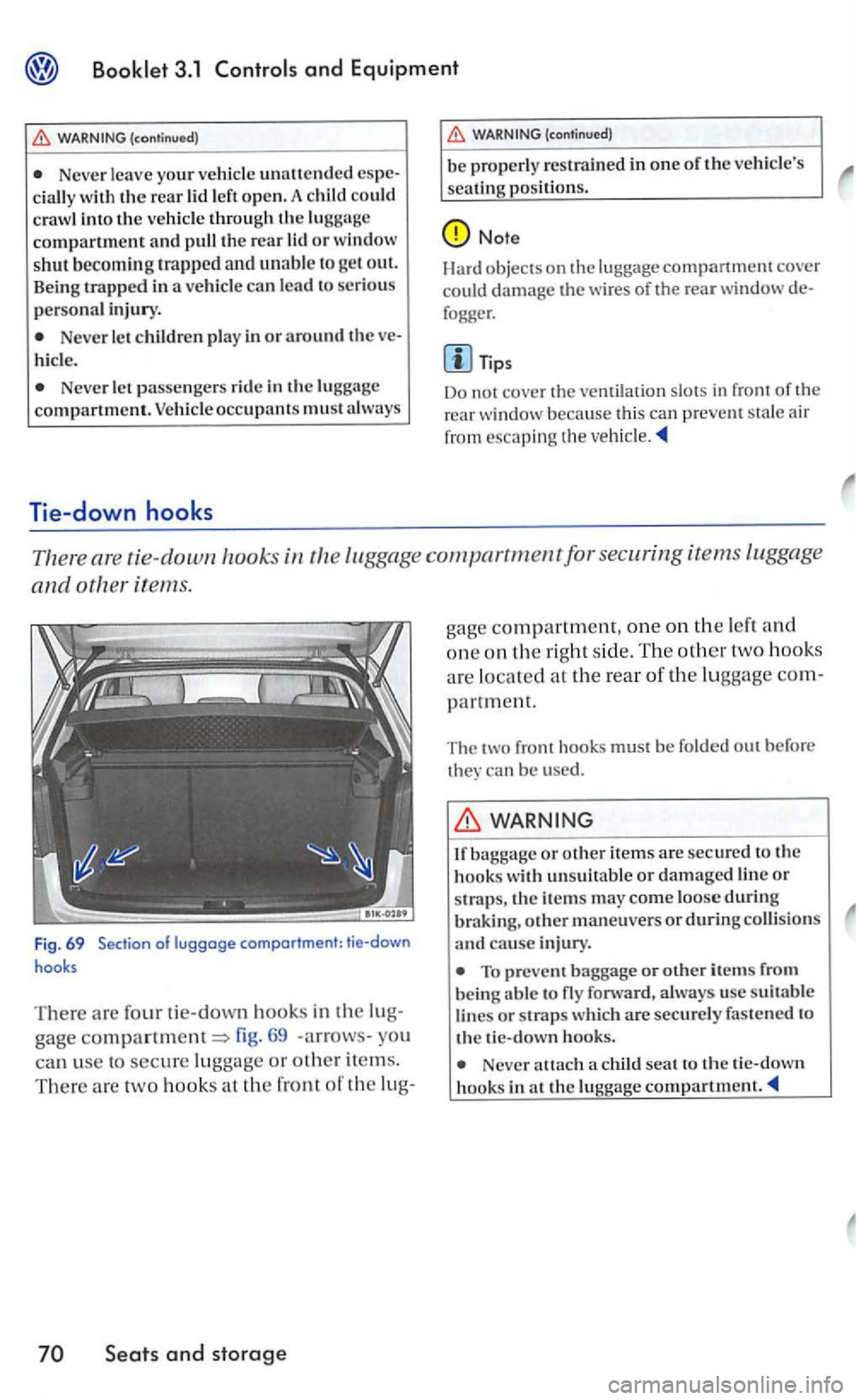
and Equipment
WARNING (continued)
Never leave your vehicle unattended cially with the rear lid left open. A could crawl into the vehicle through the luggage compartment and pull the rear lid or window
shut becoming trapped and unable to get ou t. Being trapped in vehicle lead to serious p e rsonal injury.
Never let children play in or around the
hicle.
Neve r let passengers ride in the luggage compartment. Vehicle occupants must
Tie-down hooks
WARNING (continued)
be p roperly restrained in one of the vehicle's s e a ting positions. r
Note
objects o n the luggage compartment cover could damage the wires of the rear
Tips
Do not cover the slo ts in f ront of the rear because this can p revent air
f r
om escaping the ve hicl e.
There are tie-down hooks lu ggage compartment for securing items luggag e
and items.
F ig . 69 Section of luggage comportment : tie -down
There are four tie-dow n hooks in the lug
gage fi g. 69 -arrows-you
can use to secure luggage o r other items.
T here are two hooks at the front oft h e lug-
WARNING
If baggage or other it em s are secured to the hooks unsuitable or damaged lin e or straps, the items may come loose during braking, other maneuvers or during collisions and cause injury.
To prevent baggage or ite m s from being able to fly forward, always use suitable
lines or s trap s which are securely fastened to the tic-down hooks.
Neve r a child seat to the tie-down hooks in at the luggage compartment.
Page 241 of 444
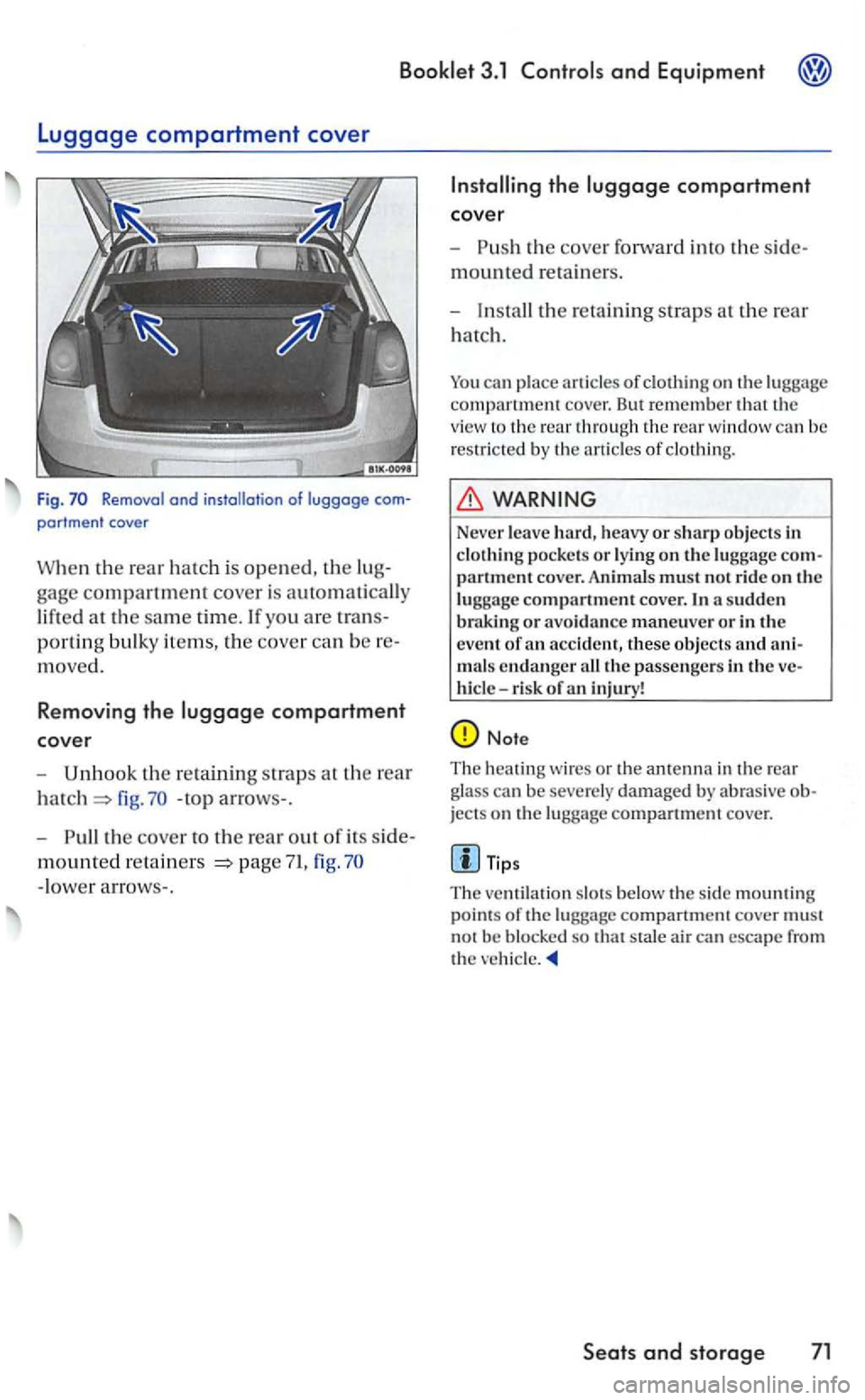
Booklet 3.1 and Equipment
Removal and partmenl cover
When the rear hatc h i s opened, the
gage compartment cover is automatically
lift
ed at th e same time. yo u are
portin g bulk y ite ms, the c ove r ca n b e
moved.
Removing the luggage compartment
cover
-Unhook the re ta in in g strap s at the rear
fig. -top arrows-.
- Pull the
cover to d1e rear out of its
m ounted r eta in ers =>pag e fig .
-lower
mounted reta iners.
- Install the re taining s
traps at th e rear
h
atch .
can place of on th e luggage
compartment cove r. B ut remember that th e
v iew to the rear throu gh the of
WARNING
Neve r leave hard, heavy or sh arp ob jec ts in pocke ts or l y ing on the luggage partment cover. Anim als mus t not rid e o n the
lu ggage compartment co ver. In a sudden braking or avoi da nce maneuver or in the eve nt of an accident, thes e object s and mals enda n ger all the passengers in the hicle -ris k of an injury !
Note
The heating wires or th e antenna in the rear glass can be severe ly da m aged by abrasive jects o n the luggage compartment cove r.
Tips
The ventil ation slo ts bel ow the side mount ing
p o int s of the luggage compartment cover must
not be blocked so that stale air ca n escape from
th e
Page 244 of 444
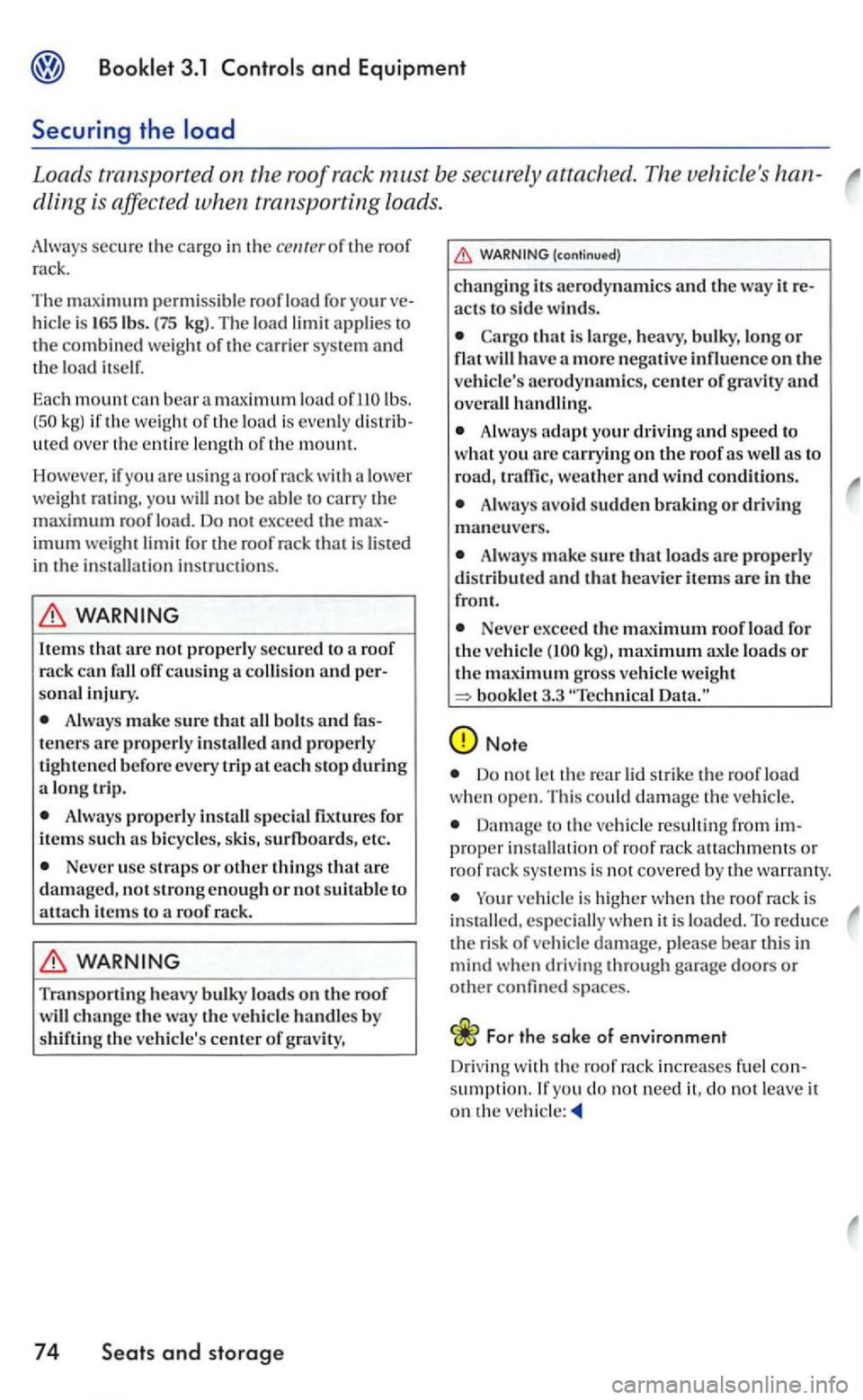
Booklet 3.1 Control s and Equipment
Securing the
Loads transported on the roof rack must be attached. The vehicle's han
dling is affec ted when transporting loads .
Always secure the cargo in th e center of the roof
rack.
Th e maximum permi
ssibl e roof load for your ve
hicle is 165 lb s. (75 kg). The load limit applies to th e combined weig ht of the carrier sys te m a nd
t h e load itse lf.
Each m ou nt can bea r a max im um loa d lbs.
imum weig ht limit for the roof rack
causing
A lw ays make sure that all and fas
t e n ers are pro perl y in stalle d and properl y
ti ght en ed befo re eve ry trip at e ac h sto p during
a long trip.
A lw ays properl y install s p ecial fixtures fo r items su ch a s bi cy cles, skis, surfboard s, etc.
Never use straps o r other things that are
d am age d, not stro n g e nough or n ot s uit able to
a tt ac h item s to a roof rack .
Transporting heavy bulky loads on the roo f
will change the way the ve hicle handles by
s hifting th e ve hicle's center or grav ity,
74 and storage
WARNING (continued )
changing its aerodynamics and th e way it reacts to sid e winds.
th at i s large, heavy , b ulky, lo n g or
Alw ays adapt your drivin g and sp eed to
w ha t yo u a rc carrying on th e roof as as to
road, t raffic, weath er a nd wind conditi ons.
Alwa ys avoid sudden brakin g or driving maneu ve rs .
A lwa ys make sure that loads arc p roperl y
dis tr ibuted and tha t heavier items are in the fro nt .
Never exceed th e maximum roofload for th e ve hicle kg). maximum axle loads or th e maximum gross vehic le weig ht booklet3.3
Note
Do n ot le t the rear lid strike the roof load
w hen open . This co uld damage the vehicle .
Damage to the vehicle resulting from im-
proper i n stallation o r roof rack attachments or
roof rack syste ms is no t covered b y th e warranty.
Your ve hicle is hig her when th e roof rack is
i n stalled, especially when it is loaded. To reduce the ris k or ve hicle damage, please bea r this in
min d when driv ing through garage doors or o ther confined spaces .
For the sa ke of envir o nment
Driv ing w ith
the roof rack increases fu e l consumption. you do not n eed it, do not leave it on the
Page 252 of 444
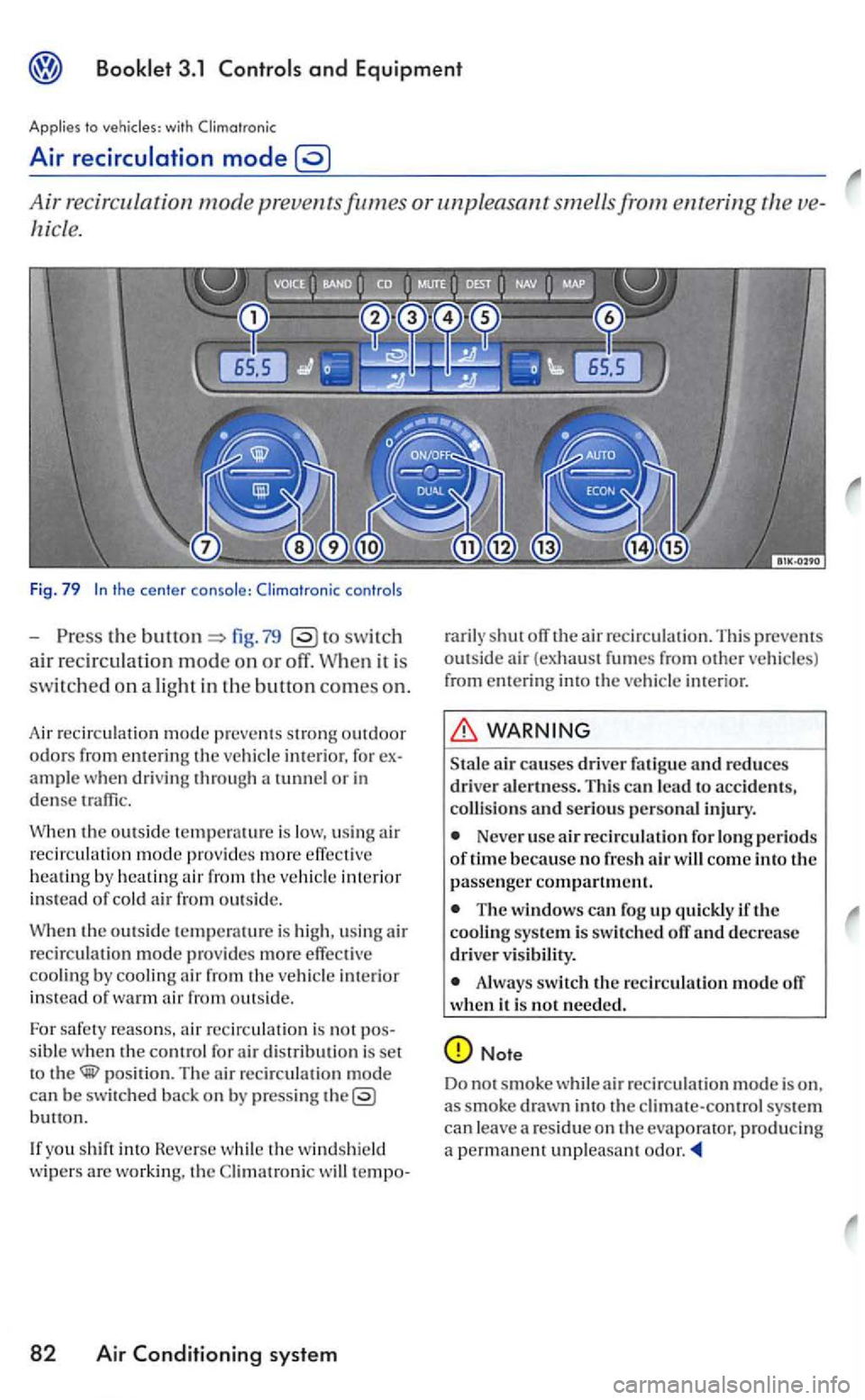
Air recirculation mode prev entsfttmes or unpleasant smells from entering
th e fig. 79 switch
air recirculat ion mode on or off. When it is
sw itch ed on a light in the
button comes on.
Air recircu lat io n mode preven ts s trong outdoor odors from entering th e int erio r. for example when drivin g through a tunnel or in dense traffi c.
the outsid e is low . u sing ai r recir cu latio n m od e prov ides more heating by hea tin g air from the interior in stead o f cold air from
th e outs ide temperature is u sin g air
recirculat ion mod e provides m ore effective b y air from the from outs id e.
For
saf e ty rea sons. air re c ircu latio n i s not pos
s ible when the control for dis tribu tio n is set
to pos ition. The a ir recircu lation mode can b e switched back on by pressi ng button.
you shift into Reve rse the w in dsh ie ld
w iper s are work ing. the t empo-
82 Air Conditioning sy ste m
shut ofT air recir culati on. This prevent s outside air (exhaust fume s from other
WARNING
Sta le ai r causes driver fa ti gu e an d reduces d river ale rtn ess. This to acci dents, and seri ous personal injury.
Neve r use air recirculatio n fo r perio d s of time because no fresh air come into the
p asse nge r compartmen t.
T he window s ca n fogupquickJyifthe syste m is sw itc hed ofT and decrease driver vis ib ili ty.
Always switc h
recircu lation mode is on. a s smoke drawn into the cl imate-control syste m can a resid ue on the evaporator. producing a permanent unpleasant
Page 257 of 444
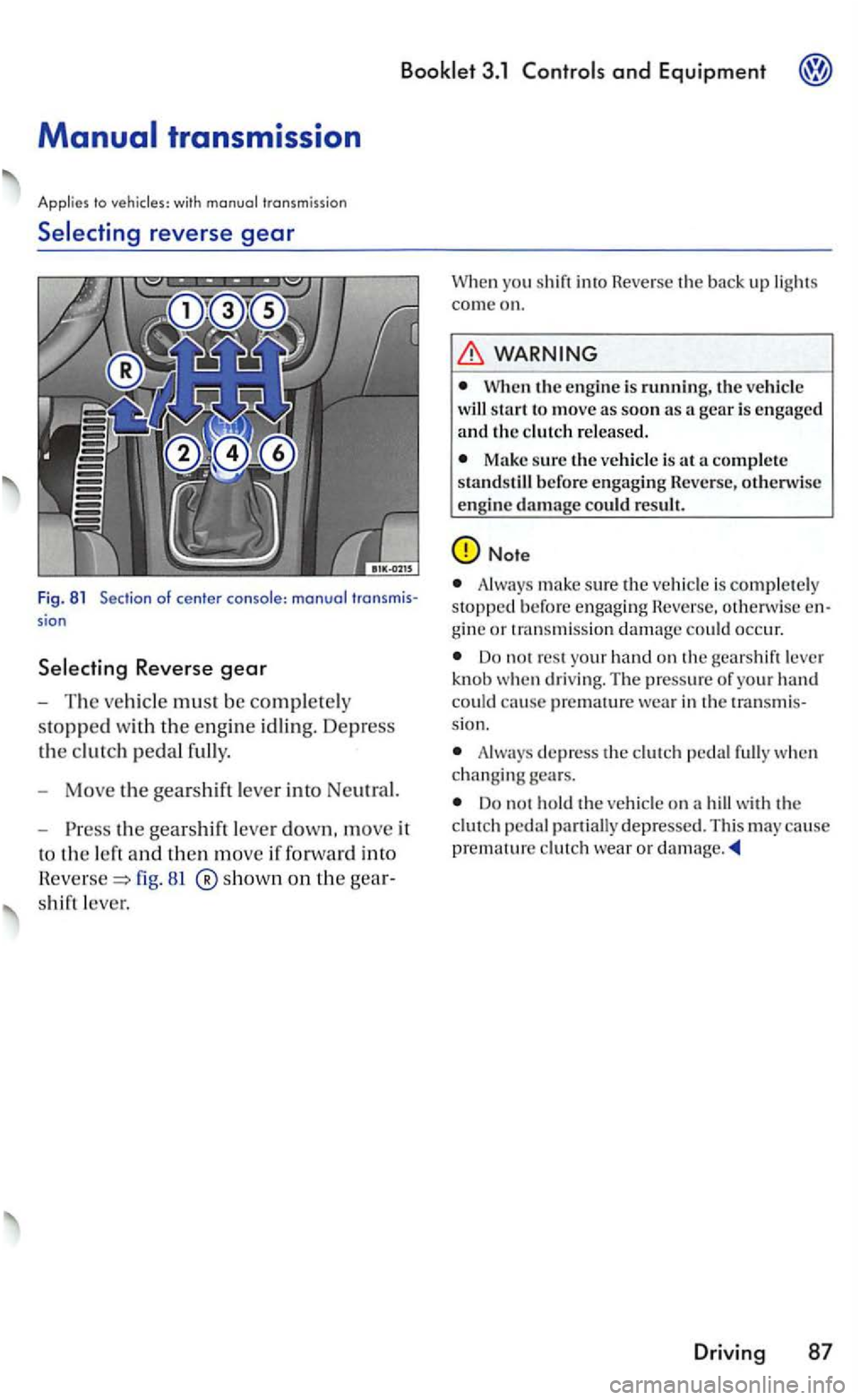
3.1 and Equipment
with
Selecting reverse gear
Fig . 81 Section of center sion
81 ®show n on th e
shift leve r.
you shif t in to Rever se th e bac k up lights
c om e on.
WARNING
When the e ngine is run n in g, t he start t o m ove as soo n as a gear is e ngaged
a nd the
Make sure the ve hicl e is at a comple te
s tandstil l b efor e engagin g Rev ers e, oth erw is e
e ng in e da mage c oul d re sult .
Always make sure the is com ple te ly stopped befo re e ngaging Reverse. othen vise
Do n o t res t your ha nd on the gears h ift leve r
knob when dri ving. The press ure of your hand
could ca use premat ure wea r in th e transmis
s ion.
Always dep ress the ped al full y w hen ch anging gears.
Do not hold the on a hill with t he peda l part ially depresse d. T his may cause
p remature clu tch wea r o r damage .
Drivi ng 87
Page 261 of 444
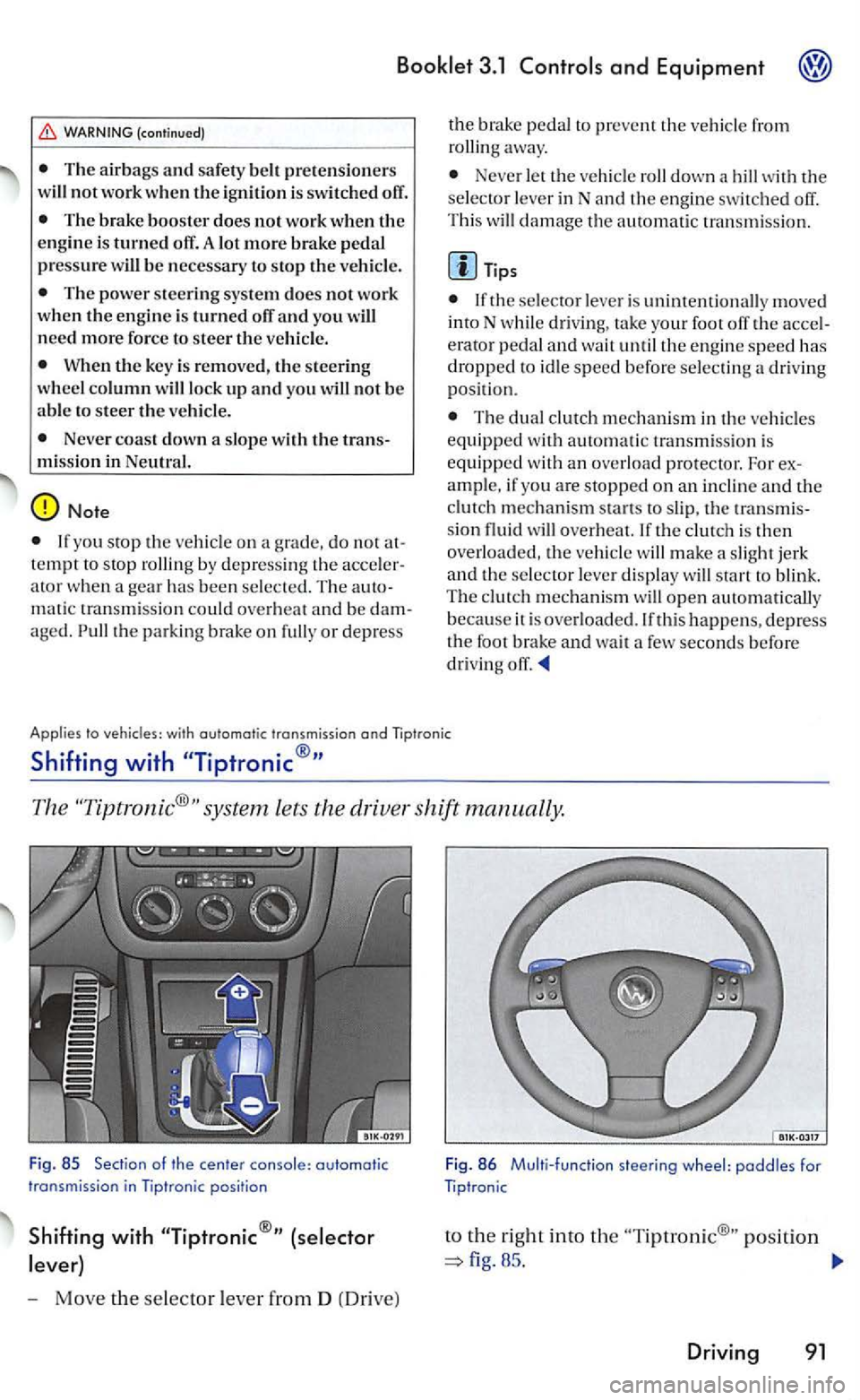
3.1
WARNING (continued)
T he air bags and safe ty be lt pre te n sio ners
will not work w he n the ign ition is switch ed off.
Th e brake booster does not work when the e ngine is turned off. A lot more brak e pedal pressu re w ill be necessary to stop the vehicle.
The power steering syste m does not work
w hen the e ngine is turned off and you will need more force to steer the ve hicl e.
When the key is removed, the s teering wheel column will lock up a n d yo u will not be able to steer the veh icle.
Neve r coast down a s lope with the tran smission in Neutral.
Note
If you stop th e ve hicle on a grade , d o not attempt to stop rolling by depres sin g th e acce le rator w hen a gea r has been se le ct ed. The automatic tra nsmi ssion could overhea t and be dam
a ge d. Pull the parkin g brake on full y or depress t
h e
brake ped al to prevent th e ve hicle from
ro llin g away.
Neve r le t the ve hicl e roll down a hill with the se lector le ver inN and the engine swit ched off .
Thi s will damage the automatic tran smission.
Tip s
lfthe sele cto r le ver is un int en tio nally m oved
int o N while driving , take your foot off the accel
era to r pedal and wa it until the engin e speed has dropped to idle sp eed b efore selec tin g a driv ing position.
The dual clut ch mechanism in the vehicl es
e quipped with au tomatic tra nsmis s io n is
equip ped with an overload pro tector. For ex
ample, if yo u are stopped on a n inclin e and the
clutch mechanis m sta rts to slip, th e transmi s
s ion fluid will ove rheat. th e clutch is then overload ed, the vehicle will m ake a slight jerk and th e s elector leve r d is play will start to blink.
T he clut ch m echanism will op en auto mati cally
because it i s o verloaded .lf th is happe n s, d epress the foot brake and wait a few se conds before
dri ving off.
Applies lo veh icles: w ith automol ic tr ansmission and
Shifting with
The system lets th e driver shift manually.
Fig. 85 of
- Move the sele c tor leve r from D (Dr iv e)
F ig . 86 Multi-function steering wheel: paddles for
to the right into the po sition
85 .
Driving 91
Page 264 of 444

Booklet 3. 1 Controls and Equipment
Applies to v ehicle s: with on automatic trans m iss io n
Kick -down function
The kick-down funct ion permits maximu m acce leration when the selecto r lever
i s
g in e reac hes th e maximum engine speed for the gear sele c ted.
Parking brake
Operation
Accelcrat ing on slippery roads can cau se loss of ve hicl e contro l a n d serio u s personal inj u ry.
Be very care ful when using the kick-down feature, especia lly on sli ppery surfaces. Ra pid accele ra ti on m ay cause wheel spin and ding.
The parkin g brake can b e
the parking
and when
yo u park your
Applying th e parking broke
th e parking brake
89 .
94 Dri ving R
e
leasing parking broke
th e up and press the
kn ob in the d irect ion of th e a rrow
89 and guide the park in g brake
down
Th e brake should always be you wo n't unintentionally drive off
wi th the parkin g brake still
\Vhe n th e ignition is on and th e parking brak e is the wa rnin g light or in the
in strume nt clu ste r w ill come on.
or goes out.
If sh o uld drive fas ter th an 4 mph (6 km /h )
wi th th e parking brake still enga ged, the fol-
lowin g inform ation tex t appears in the m ent cluste r d is pla y: BRAKE A warning signal sounds as well.
Page 265 of 444
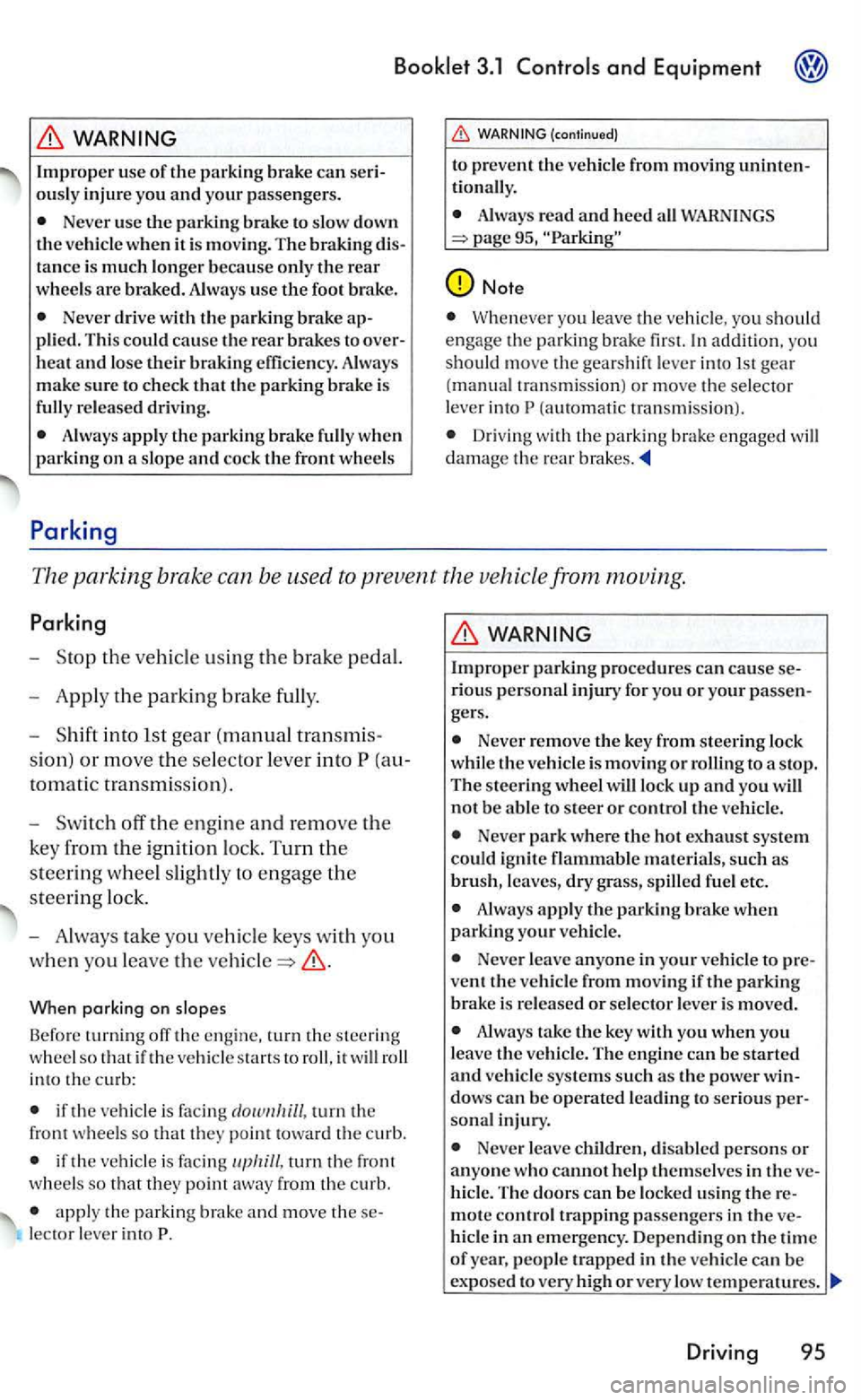
Booklet 3.1 Controls and Equipment
WARNING
Improper use of the parking brake can seri
ousl y injur e yo u and your passenge rs.
Neve r use the parking brake to slo w down
th e ve hicle when it is mov ing. The braking tanc e is much longer because only the rear wheel s are braked. Alwa ys use the foot brake.
Neve r drive with the parking brake plied. This could cause the rear brakes to overheat and los e their braking efficiency. Always
make sure to check that the parkin g is
fully re le a sed dri vin g.
Always apply the parking brake fully when
parking on a slope and cock the front wheels
Parking
(co ntinue d)
to prevent the vehicle from moving
Always read and h ee d WARNINGS
Whe never you leave th e veh icle, you should engage the parkin g
(aut om ati c tra nsm ission) .
Driving w ith the parking brake engaged will damage the rear
The parking bra ke can be used to prevent th.e vehicle from moving.
Parking
-the vehicle using the brake
-Apply th e parkin g brake full y.
-
into lst gear (m anual transmi s
sio n)
or move the se lector lever into
When parking on slo pes
Before turn ing off the engine, turn the steering
w hee l so that if th e vehicle starts roll, it will roll into the curb:
if the vehicle is facing turn the
f ront wheels so that they point toward the curb.
if th e veh ic le is facin g
apply the parkin g brake and m ove theselector leve r into
WARNING
Improper parki ng procedures can cause riou s personal injury for yo u or your passe n
gers.
Neve r remove the key from steering lock
while the ve hicl e is moving or rolling to a s top . The steering wheel will lock up and yo u will not be abl e to steer or contro l th e vehicle.
Neve r park where the hot exhaust system could ig nit e flammable materi als, such as brush, leaves, dry g ra ss, spill ed fue l e tc.
A lwa ys apply the parking brake when parking your vehi cle.
Neve r leave anyone in your vehi cle to vent the ve hicle from movin g if the parking brake is released or selector lever is moved.
Always take th e key with yo u when you leave the vehicle. The engin e ca n b e started and veh icle syste m s s uch as the powe r dows can be operated leadi ng to serious sonal injury.
Neve r leave childre n, disabl ed person s or anyone w ho cannot h elp th e mselves in the hicle. The doors can be locked using th e re-
m ote control trapping passe ngers in the h icle in an emerge ncy . Depending on the tim e of year, peo ple trapped in th e vehicle can be ex po sed to very high or very low temperatures.
Driving 95